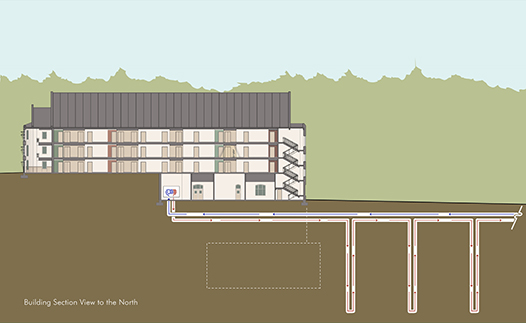Expertise
Energy
Reducing building energy use not only lessens the single largest environmental impact of building operations, but also reduces the cost of operations. Our team of building performance analysts brings a quantitative approach to optimizing building performance.
The Architecture 2030 Challenge and The AIA 2030 Commitment
Both 2030 programs advocate ramping up energy performance targets of building designs so as to achieve carbon-neutral design by the year 2030. LAS has been a signatory to the Architecture 2030 Challenge and the AIA 2030 Commitment since their inception. They are used as a framework on projects to set energy performance targets, identify measures and report progress annually.
Passive Solar Design
The building itself can be designed to function as a passive mechanical system. Computational Fluid Dynamics (CFD) Analysis was utilized to optimize the design of the passive solar Trombe walls at the Blue Ridge Parkway Destination Center, which harvest solar energy for winter heating. A radiant hot water loop provides supplemental heating during peak demands. The passive solar design was a critical energy efficiency measure contributing to the Blue Ridge Parkway building’s projected 75 percent reduction in energy use. At the Southface Eco Office, shading devices are optimized to prevent unwanted summer heat gains while allowing passive solar heating in the winter.
Our in-house Building Performance Analysts provide energy modeling, solar analysis and CFD modeling to help inform the design process.
Photovoltaic (Solar) Power
Renewable energy systems can either be visible green design statements, such as the semi-transparent skylight-integrated array at the Southface Eco Office, or they can be invisible clean power sources, such as the roof-top arrays at the Biodesign Institute at Arizona State University and the Global Institute of Sustainability. The ‘solar garden’ at the Hardman Farm sensitively blends modern renewable energy technology with historic preservation.
Solar Thermal
With a much shorter financial payback than photovoltaic (solar electric) systems, solar thermal systems provide a cost effective strategy for capturing renewable energy to offset conventional energy use. In this example at the LEED Gold certified Skidaway Oceanographic Research Institute, a solar hot water system captures energy from the sun to provide domestic hot water.
Ground Source Heat Pumps
Also commonly called ‘geothermal’ heat pumps, ground source heat pumps use the relatively stable temperature of the earth to serve as a heat sink for the rejection of heat in the summer and the supply of heat in the winter. These systems can dramatically reduce a building’s energy use and carbon footprint. The LEED Gold certified Graduate Housing at Columbia Theological Seminary makes use of this largely invisible energy-saving technology. This technology was a key energy efficiency measure contributing to the project’s projected 50 percent reduction in energy use.
Sun Shading
Sunshades are not only a means of preventing unwanted solar heat gain and controlling glare, but they can also become expressive design elements and visible green design features.





